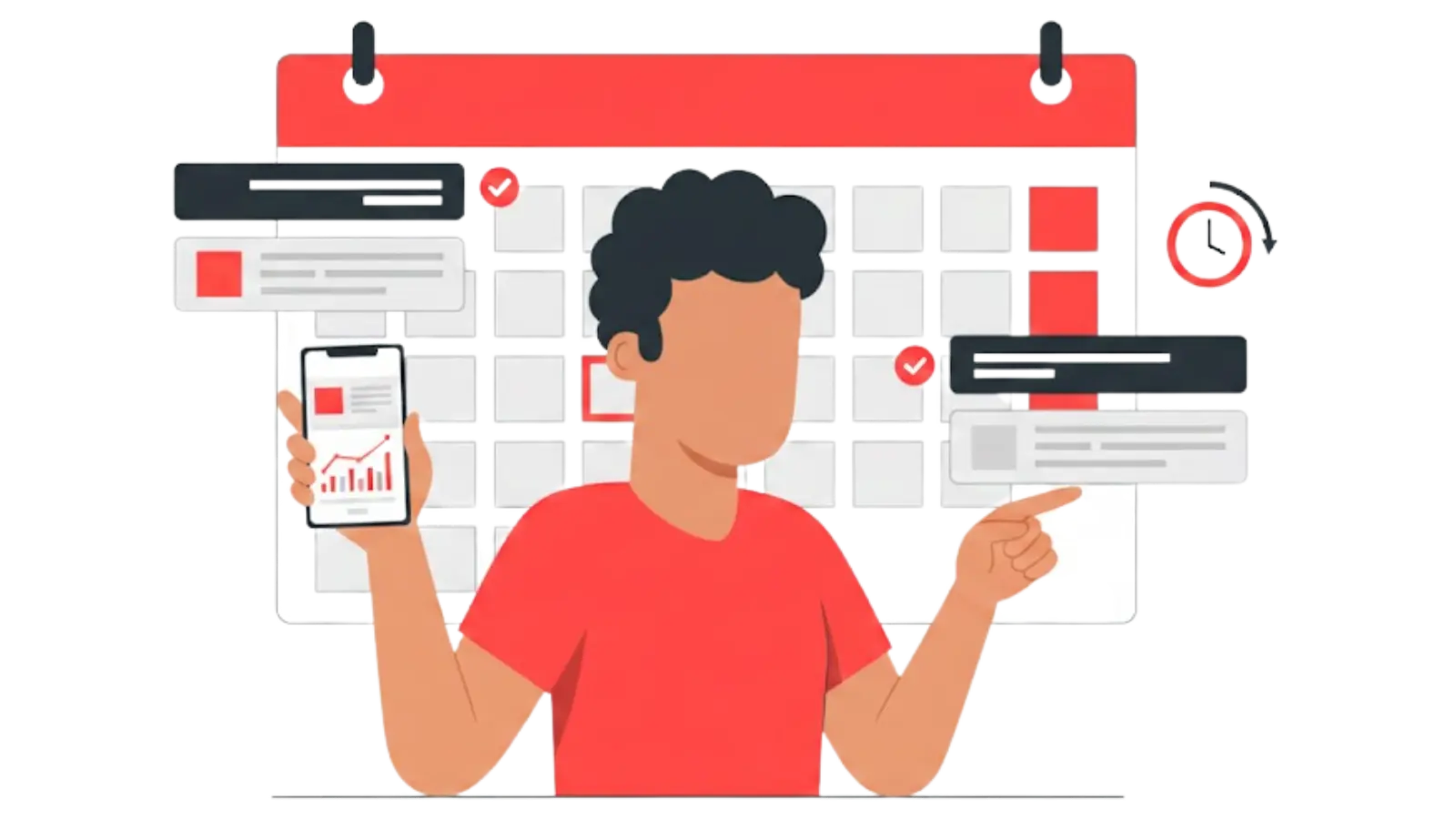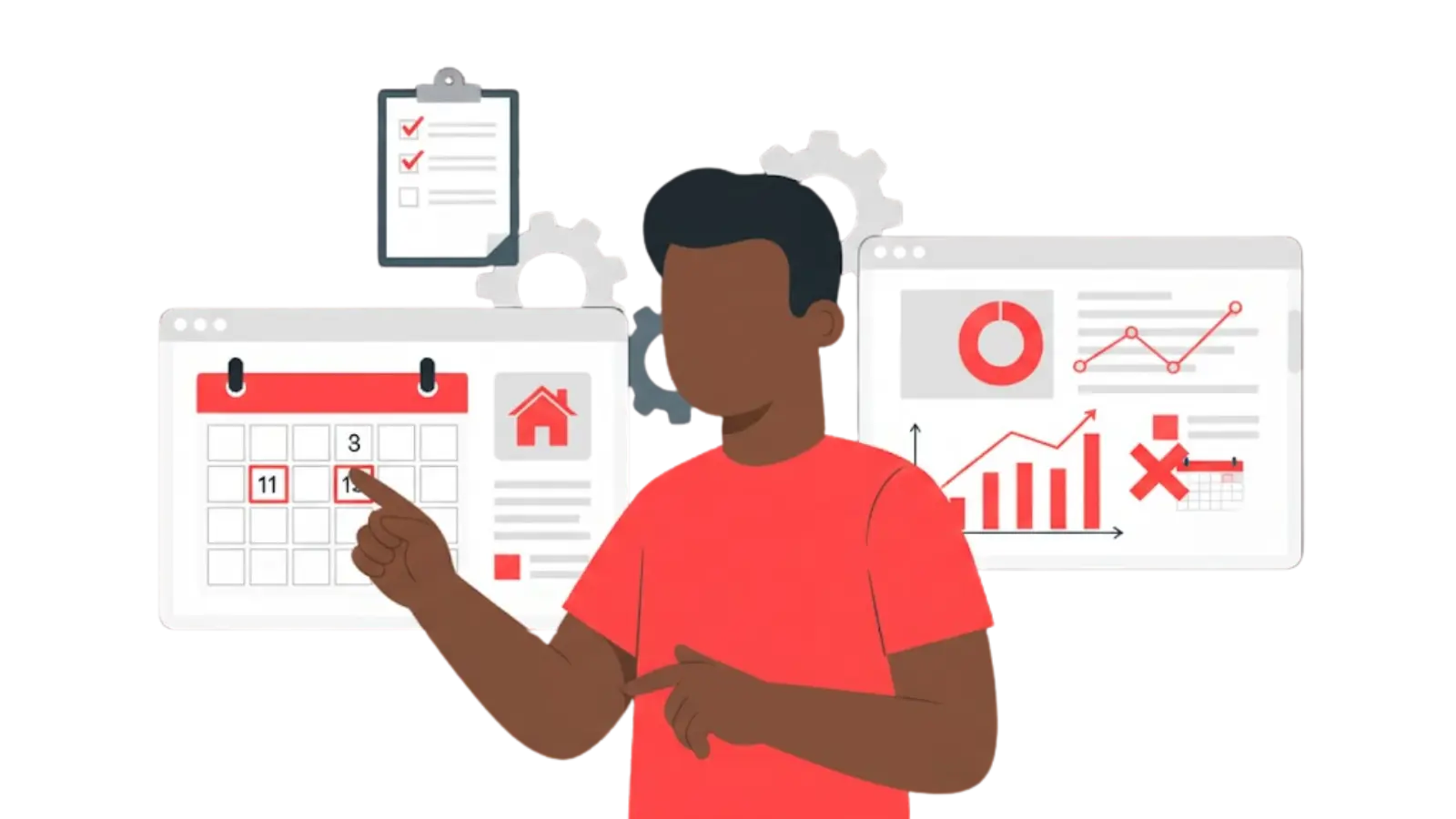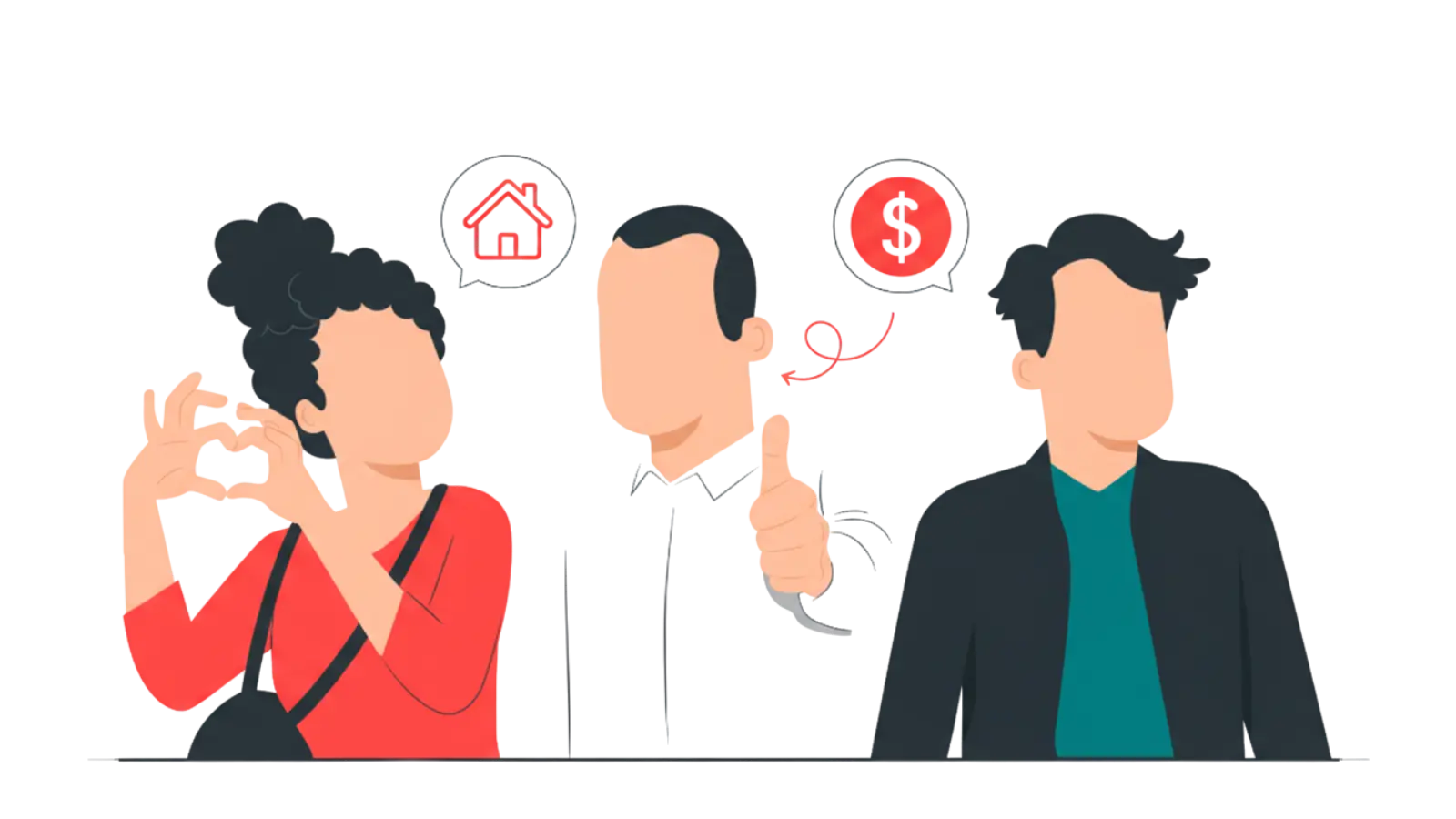Updated : Apr 15, 2025
In part 1 of our series on ‘How to Optimize Your Airbnb Listings in 2025?’, we explained how to optimize your listings. In this article, we’ll focus on optimizing your listings’ pricing.
The short-term rental market is highly competitive. Key Data has reported that the supply growth in the US remains strong at approximately 10% this year. While significant, this is a slowdown from about 20% growth reported two years ago.
Your prices must also reflect changing market conditions. In this guide, we’ll help you understand how to price your property to optimize your listing for success.
Step 1: Research the Market
You can not price your property in isolation. The first step to pricing your property to optimize your listing for success would be understanding your competitors and the market.
- How are your competitors pricing their property?
- How are guests booking properties in your locality?
- How long are guests staying at your property?
You should also understand the price range at which guests book your property. If you are not priced in that range, your target audience will not be able to find you even if you are the best property in the market.
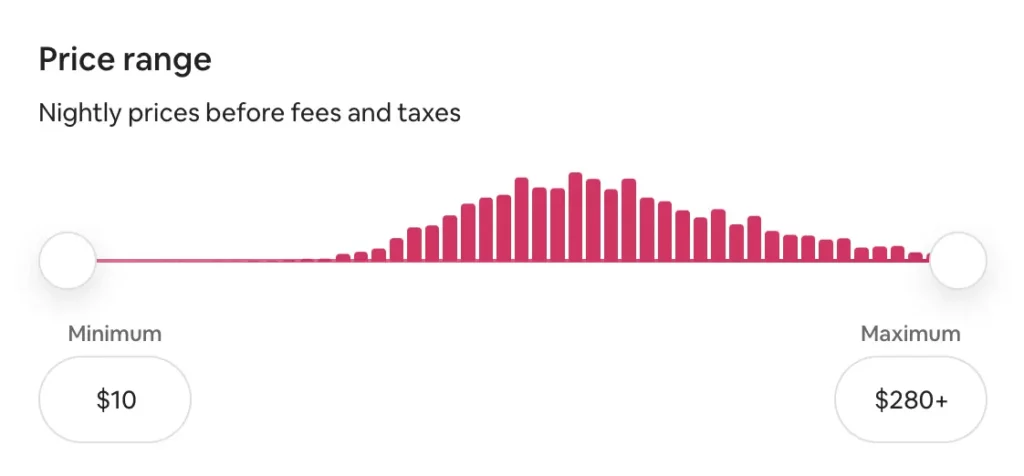
In PriceLabs Neighborhood Data’s Market History chart, you can find the market’s Occupancy, Booking Window, Average Daily Rate (ADR), and Length of Stay. By default, the chart shows data for the last year but can be changed to show data for the previous two years.

Once you’ve understood the market, you should research your direct competitors. The Competitor Calendar allows you to choose the listings in your locality that are your competitors.

We have also added a thumbnail option to quickly check if you’ve pulled the right listing without having to move tabs each time.
You can also track the fees: Airbnb Service Fees and Cleaning Fees that your competitors add for their properties. Once you understand the market standards, you should factor in your costs and set your fees for maximum profit.
You should also understand the minimum stay restrictions that your competitors have set for their property; this will help you know your target guests’ booking patterns.
If more than 2 nights are being booked, you know that you should also have a 2-night minimum. If the standard is longer stays, then you should also focus on longer stays if that fits your hosting strategy.

Step 2: Analyze Your Performance
While looking at how your competitors are pricing their property is important, you should also look at how your property has been performing over the years.
Key questions that you should answer:
- How has my occupancy fared compared to the market?
- How was my pricing in contrast to the occupancy?
To understand your occupancy, look at our Occupancy graph in Neighborhood Data. When you optimize your Airbnb listings’ pricing strategy for January ‘25 now, this graph will help you understand where you stand.
For example, the graph below for July 4th shows very low market occupancy. In last year’s data, occupancy is at 51.30%. This indicates that there’s still room for occupancy to pick up. Bookings might come in the next few months.

This information can help you understand if your current pricing needs any improvements. If last year’s occupancy does not match how it looks now, you need to take a step back and reassess your offering.
You can also use the Pacing Charts available in our Portfolio Analytics. This will help you track how your listings compare to others in more detail; you can also check how you are pacing with yourself.
The Pacing chart gives insights into your booking rate against a benchmark like last year or the market in general. You can gauge, when you optimize your Airbnb listings, whether your listings are lagging or if things are running smoothly.

Step 3: Set Your Prices
Research is only as good as the implementation! Once you’ve gathered your insights, you should start pricing your properties.
The first step is to set your Base Price. This is the price over which all customizations and pricing recommendations in PriceLabs are applied. You should set your base price based on the quality of your property.
| 📌 Note: Avoid setting your base price too low to secure far-out bookings or to stay competitive or too high because you over-estimated the quality of your property. The goal here is to attract bookings that can also gather high-quality reviews. Extreme pricing will price you out of the market quite quickly. |
You can also use the Base Price Help tool to set your Base Price. It helps determine a good starting point for your listing’s base price by analyzing listings nearest to yours.
Remember: your Base Price can not be constant. It has to keep changing, so keep monitoring Base Price Nudges. These nudges help us keep track of your base price and alert you if there’s a significant difference (over 5%) between your current base price and our recommended base price.

Once you’ve set your Base Price, the next step is to set your minimum price. This price is the absolutely lowest price you’re willing to sell a night at your property for. This will ensure that our algorithm is aware of your thresholds and is able to respect them.
It is important that you are flexible with your minimum price at the beginning. If you’ve been able to go beyond an amount that covers cost and also provides profit, try experimenting with it when you optimize your Airbnb listings, a little to see if you can get more profits.
We keep a close eye on your minimum price as well. If we notice that at least 21 available days in the next 30 are set at your Minimum Price and it hasn’t been adjusted in the last 10 days, we’ll recommend a 5% reduction. This ensures that your pricing remains competitive, giving the algorithm more flexibility to adjust for low-demand dates and helping you secure more bookings.

Step 4: Consider Length Of Stay Pricing Strategies
You have the foundational strategy sorted; you now need to start considering edge cases. If you discover that your market is primarily last-minute, you need a last-minute pricing strategy. The same is true if you are in a far-out market. What if you are in a mid-term market? Few markets function as both mid-term and short-term rental markets!
You need a strategy that considers all of these cases as well.
1. Last-minute pricing strategy
For stays within the next 30 days, you should consider offering last-minute discounts. This will help you fill up your calendar faster.

Before diving into pricing, you should understand what last-minute stays look like. Are you comfortable with a 1-day window to turn around your property for a stay? If yes, then set this up accordingly. In the weekday and weekend slots in the screenshot above, you get the option of setting up 5 rules or formations in which you are okay with accepting last-minute bookings.

Once you know the kind of last-minute stays you are comfortable hosts, you should start considering how you would price those stays as well. You can either have a fixed cost or a fixed percentage cost. If you set a gradual % of -15% within the next 15 days, then for each day, there would be a 1% discount in your pricing until it accumulates to 15% at the end of the range.
Generally, a range is better than an absolute! This provides our tool as well with more flexibility to appropriately recommend your property.
2. Far-out Pricing Strategy
If you want to open your calendar for more than 90 days at once, consider a far-out pricing strategy.

Same as with a last-minute pricing strategy, you need to decide the far-out bookings you are okay with taking up. Add the minimum night requirements here. According to this, you can also price your property for far-out prices.

3. Orphan Gap Pricing Strategy
Let’s say you have two bookings that leave two days unbookable in the middle because of your minimum stay requirements. This is an orphan gap.
Here, you have the flexibility to actually change your minimum stay requirements to allow for orphan gaps.
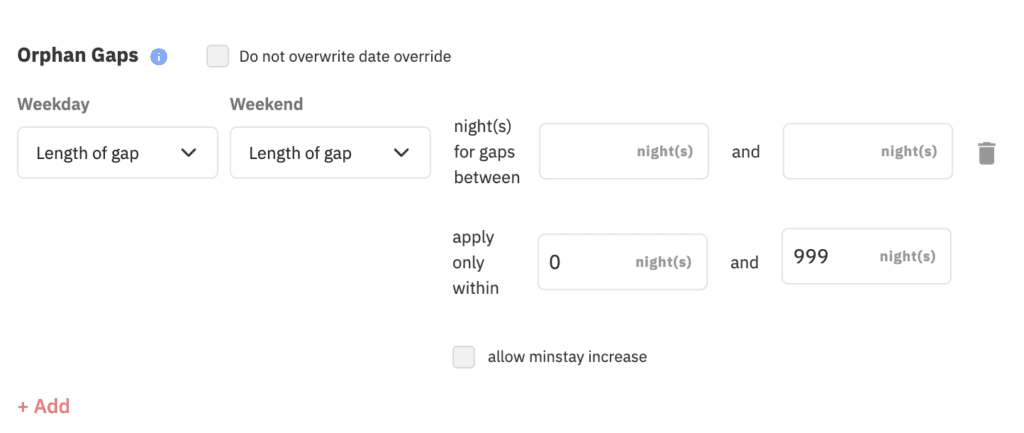
You can also change your prices for those specific orphan gaps in your calendar.

4. Understand your Seasons
At first glance, setting your rental prices at the neighborhood median might seem logical—it’s a fair reflection of the market, right? However, this approach often fails to maximize your revenue.
Here’s why:
- High Demand Periods: During peak times—like holidays, local events, or weekends in popular leisure destinations—demand soars, and most properties in the area are likely to get booked. Sticking to the median price in such periods means missing the opportunity to charge a premium.
- Low Demand Periods: In quieter times, competition intensifies as fewer travelers book stays. Pricing at the median may result in your property being overlooked. Lowering your rates strategically can improve your chances of securing bookings without sacrificing profitability, thanks to seasonal minimum price settings.
While high- and low-demand periods are easy to understand, there’s a middle ground called medium-demand periods or “shoulder seasons.” These are times when demand isn’t as predictable and changes daily.
Unlike peak periods, where higher prices work, or low-demand times, where lower prices attract bookings, shoulder seasons need a balanced approach. Setting prices too high might push guests away, while going too low can leave money on the table.
By keeping your pricing flexible during these periods, you can stay competitive and capitalize on fluctuating demand.
Rather than simply mirroring the market when you decide to optimize your Airbnb listings, it’s better to leverage tools like PriceLabs’ Dynamic Pricing algorithm, which adjusts rates based on occupancy trends, seasonality, and upcoming events.
Remember, pricing strategies should be tailored to your property. For example, luxury homes may consistently perform well above median prices, which can be reflected through a higher base rate and strategic minimums.
Optimize for revenue, not averages—pricing dynamically ensures you’re ready to capture demand shifts while staying ahead of the competition.
Optimize Your Listing's Airbnb Pricing With PriceLabs Dynamic Pricing Tool!
Static pricing is the enemy of your Airbnb. Understand your market and competitors, understand seasonality to price your property dynamically
Start your 30-day FREE trial now!Key Features of PriceLabs Dynamic Pricing Tool
- Real-time market analysis: PriceLabs continuously monitors local data, including similar rentals, major events, holidays, and booking trends. This ensures your pricing reflects the most current market conditions, keeping you competitive.
- Hyper-local tailoring: The tool goes beyond broad trends by factoring in hyper-local elements like nearby attractions, amenities, and neighborhood demand. This customized approach helps you attract the right guests at the right price.
- Demand forecasting: By analyzing past and present booking patterns, PriceLabs predicts future demand. During peak times, it raises rates to maximize earnings, while during slower periods, it lowers them to maintain a steady flow of bookings.
- Customizable settings for control: While the tool provides data-backed recommendations, you remain in charge. Set minimum prices, cap maximum rates, or fine-tune suggestions to align with your unique goals and market knowledge.
- Automated updates across platforms: PriceLabs simplifies your workflow by syncing updated prices automatically across platforms like Airbnb and Vrbo. This saves time, ensures consistency, and avoids potential pricing errors.
Why Should You Choose PriceLabs?
PriceLabs is a revenue management solution for the short-term rental and hospitality industry, founded in 2014 and headquartered in Chicago, IL. Our platform helps individual hosts and hospitality professionals optimize their pricing and revenue management, adapting to changing market trends and occupancy levels.
With dynamic pricing, automation rules, and customizations, we manage pricing and minimum-stay restrictions for any portfolio size, with prices automatically uploaded to preferred channels such as Airbnb, Vrbo, and 120+ property management and channel integrations.
Every day, we price over 500,000+ listings globally across 135+ countries, offering world-class tools like the Base Price Help and Minimum Stay Recommendation Engine.
Choose PriceLabs to increase revenue and streamline pricing and revenue management. Sign up for a free trial at pricelabs.co today.
Optimize Your Airbnb Listings’ Pricing to Maximize Occupancy and Revenue
Staying on top of Airbnb pricing trends isn’t just about following the crowd—it’s about ensuring your property stays competitive and irresistible to guests.
As 2025 approaches, travelers expect value for money and tailored experiences, and your pricing strategy plays a massive role in delivering both.
Aligning your pricing with guest expectations, from adjusting rates for peak seasons and local events to offering discounts for extended stays or last-minute bookings, ensures your property stays in demand.
Dynamic pricing tools, like PriceLabs, can help you stay agile by tracking market trends and optimizing your rates in real-time.
When your pricing reflects what travelers seek—affordability during quiet seasons or premium rates for one-of-a-kind stays—you’re not just setting prices. You’re securing consistent bookings and positive reviews.
Keeping your pricing flexible, data-driven, and aligned with demand is key. Nail this, and your calendar will fill up as quickly as you can say, “Fully booked!”



